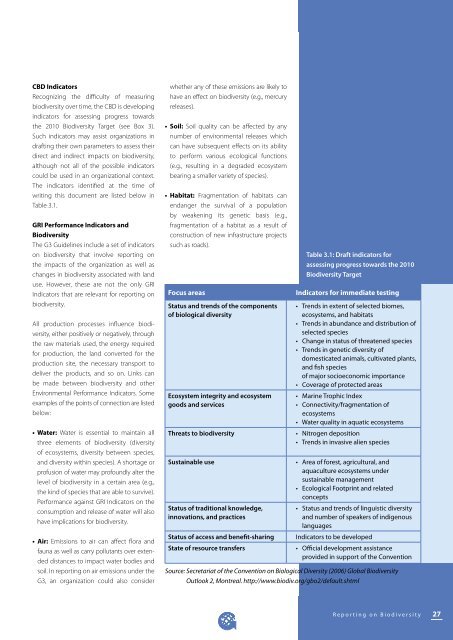Biodiversity - a GRI Reporting Resource - Global Reporting Initiative
Biodiversity - a GRI Reporting Resource - Global Reporting Initiative
Biodiversity - a GRI Reporting Resource - Global Reporting Initiative
Create successful ePaper yourself
Turn your PDF publications into a flip-book with our unique Google optimized e-Paper software.
CBD Indicators<br />
Recognizing the difficulty of measuring<br />
biodiversity over time, the CBD is developing<br />
indicators for assessing progress towards<br />
the 2010 <strong>Biodiversity</strong> Target (see Box 3).<br />
Such indicators may assist organizations in<br />
drafting their own parameters to assess their<br />
direct and indirect impacts on biodiversity,<br />
although not all of the possible indicators<br />
could be used in an organizational context.<br />
The indicators identified at the time of<br />
writing this document are listed below in<br />
Table 3.1.<br />
<strong>GRI</strong> Performance Indicators and<br />
<strong>Biodiversity</strong><br />
The G3 Guidelines include a set of indicators<br />
on biodiversity that involve reporting on<br />
the impacts of the organization as well as<br />
changes in biodiversity associated with land<br />
use. However, these are not the only <strong>GRI</strong><br />
Indicators that are relevant for reporting on<br />
biodiversity.<br />
All production processes influence biodiversity,<br />
either positively or negatively, through<br />
the raw materials used, the energy required<br />
for production, the land converted for the<br />
production site, the necessary transport to<br />
deliver the products, and so on. Links can<br />
be made between biodiversity and other<br />
Environmental Performance Indicators. Some<br />
examples of the points of connection are listed<br />
below:<br />
• Water: Water is essential to maintain all<br />
three elements of biodiversity (diversity<br />
of ecosystems, diversity between species,<br />
and diversity within species). A shortage or<br />
profusion of water may profoundly alter the<br />
level of biodiversity in a certain area (e.g.,<br />
the kind of species that are able to survive).<br />
Performance against <strong>GRI</strong> Indicators on the<br />
consumption and release of water will also<br />
have implications for biodiversity.<br />
• Air: Emissions to air can affect flora and<br />
fauna as well as carry pollutants over extended<br />
distances to impact water bodies and<br />
soil. In reporting on air emissions under the<br />
G3, an organization could also consider<br />
whether any of these emissions are likely to<br />
have an effect on biodiversity (e.g., mercury<br />
releases).<br />
• Soil: Soil quality can be affected by any<br />
number of environmental releases which<br />
can have subsequent effects on its ability<br />
to perform various ecological functions<br />
(e.g., resulting in a degraded ecosystem<br />
bearing a smaller variety of species).<br />
• Habitat: Fragmentation of habitats can<br />
endanger the survival of a population<br />
by weakening its genetic basis (e.g.,<br />
fragmentation of a habitat as a result of<br />
construction of new infrastructure projects<br />
such as roads).<br />
Focus areas<br />
Status and trends of the components<br />
of biological diversity<br />
Ecosystem integrity and ecosystem<br />
goods and services<br />
Threats to biodiversity<br />
Sustainable use<br />
Status of traditional knowledge,<br />
innovations, and practices<br />
Status of access and benefit-sharing<br />
State of resource transfers<br />
Table 3.1: Draft indicators for<br />
assessing progress towards the 2010<br />
<strong>Biodiversity</strong> Target<br />
Indicators for immediate testing<br />
• Trends in extent of selected biomes,<br />
ecosystems, and habitats<br />
• Trends in abundance and distribution of<br />
selected species<br />
• Change in status of threatened species<br />
• Trends in genetic diversity of<br />
domesticated animals, cultivated plants,<br />
and fish species<br />
of major socioeconomic importance<br />
• Coverage of protected areas<br />
• Marine Trophic Index<br />
• Connectivity/fragmentation of<br />
ecosystems<br />
• Water quality in aquatic ecosystems<br />
• Nitrogen deposition<br />
• Trends in invasive alien species<br />
• Area of forest, agricultural, and<br />
aquaculture ecosystems under<br />
sustainable management<br />
• Ecological Footprint and related<br />
concepts<br />
• Status and trends of linguistic diversity<br />
and number of speakers of indigenous<br />
languages<br />
Indicators to be developed<br />
• Official development assistance<br />
provided in support of the Convention<br />
Source: Secretariat of the Convention on Biological Diversity (2006) <strong>Global</strong> <strong>Biodiversity</strong><br />
Outlook 2, Montreal. http://www.biodiv.org/gbo2/default.shtml<br />
R e p o r t i n g o n B i o d i v e r s i t y<br />
27

















